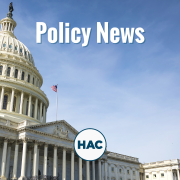HUD Programs Slated for Funding Increases
Information on FY22 USDA funding
UPDATE March 11, 2022 – Both the House and Senate have passed the omnibus bill and President Biden will sign it into law, avoiding a government shutdown and funding federal programs through fiscal year 2022, which ends on September 30, 2022.
March 9, 2022 – Many HUD programs will receive more funding in fiscal year 2022 than in 2021 under the provisions of the omnibus appropriations bill released overnight. Generally, however, the final figures fall below the highest increases proposed by the Biden administration, the House, or the Senate.
The SHOP program was increased from $10 million in FY21 to $12.5 million – the first increase in the program since FY15. The spending agreement also encourages HUD to consider increasing the per-unit cap for the combined cost of land acquisition and infrastructure improvements under the SHOP program, which is currently $15,000 per unit.
The bill includes funds for 25,000 new rental vouchers, a step towards the 300,000 new vouchers that would have been provided by the Build Back Better Act.
The substantial increase in CDBG funding was driven nearly entirely by the return, after a 10-year absence, of $1.5 billion for the Economic Development Initiative for the purpose of funding Community Projects/Congressionally Directed Spending (popularly known as “earmarks”).
The continuing resolution that currently funds the federal government ends at midnight on March 11. The House is expected to pass the omnibus bill on March 9. Another continuing resolution, lasting just a few days, may be needed to give the Senate enough time to act.
| HUD Program
(dollars in millions) |
FY20 Final Approp. | FY21 Final Approp. | FY22 Admin. Budget | FY22 House Bill | FY22 Senate Bill | FY22 Final |
| CDBG | $3,425 | $3,475 | $3,770 | $4,688 | $4,190 | $4,841 |
| HOME | 1,350 | 1,350 | 1,850 | 1,850 | 1,450 | 1,500 |
| Self-Help Homeownshp. (SHOP) | 10 | 10 | 10 | 15 | 15 | 12.5 |
| Veterans Home Rehab | 4 | 4 | 4 | – | 4 | 4 |
| Tenant-Based Rental Asstnce. | 23,874 | 25,778 | 30,442 | 29,216 | 27,719 | 27,370 |
| VASH setaside | 40 | 40 | – | 20 | 50 | 50 |
| Tribal VASH | 1 | 5 | 5 | 5 | 5 | 5 |
| Project-Based Rental Asstnce. | 12,570 | 13,465 | 14,060 | 14,010 | 13,970 | 13,940 |
| Public Hsg. Capital Fund | 2,870 | 2,942 | 3,678 | 3,718 | 3,794 | 3,388 |
| Public Hsg. Operating Fund | 4,549 | 4,864 | 4,917 | 4,922 | 5,044 | 5,064 |
| Choice Neighbrhd. Initiative | 175 | 200 | 250 | 400 | 200 | 350 |
| Native Amer. Hsg. | 825 | 825 | 1,000 | 950 | 1,000 | 1,002 |
| Homeless Assistance Grants | 2,777 | 3,000 | 3,500 | 3,420 | 3,260 | 3,213 |
| Hsg. Opps. for Persons w/ AIDS | 410 | 430 | 450 | 600 | 450 | 450 |
| 202 Hsg. for Elderly | 793 | 855 | 928 | 1,033 | 956 | 1,033 |
| 811 Hsg. for Disabled | 202 | 227 | 272 | 352 | 227 | 352 |
| Fair Housing | 70.3 | 72.6 | 85 | 85 | 85 | 85 |
| Healthy Homes & Lead Haz. Cntl. | 290 | 360 | 400 | 460 | 400 | 415 |
| Housing Counseling | 53 | 57.5 | 85.9 | 100 | 57.5 | 57.5 |
October 20, 2021 – The Senate Appropriations Committee has released nine proposed appropriations bills, including the Transportation-HUD bill, for the fiscal year that began on October 1. The committee would increase many programs above their FY21 funding levels, though generally it would not raise them to the figures proposed in the House bill. The Self-Help Homeownership Opportunity Program (SHOP) is an exception, set in both the House and Senate bills at $15 million rather than the $10 million it received in FY21. Native American housing would also receive more under the Senate bill than from the House. Details are provided in the table below.
Federal programs are currently funded through a continuing resolution that keeps them at FY21 levels. It will expire on December 3, 2021.
July 29, 2021 – The full House passed H.R. 4502, a “minibus” containing several FY22 appropriations bills, including the bills for both HUD and USDA.
July 16, 2021 – The House Appropriations Committee has approved the Transportation-HUD funding bill. It is expected to be considered by the full House as part of a “minibus” package of several FY22 appropriations bills, which will also include the Agriculture bill.
July, 2021 – On July 16, 2021 the House Appropriations Committee will consider a fiscal year 2022 funding bill for the Departments of Transportation and Housing and Urban Development. The bill was approved on July 12 by the T-HUD Appropriations Subcommittee.
The House bill would set funding levels for many HUD programs at or above the amounts requested in the President’s budget and would provide substantial increases above FY21 levels for almost all programs. Details are provided in the table below.



